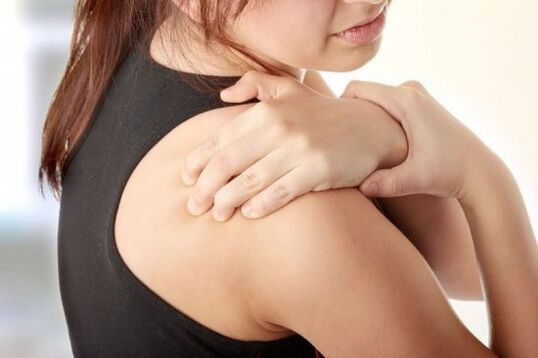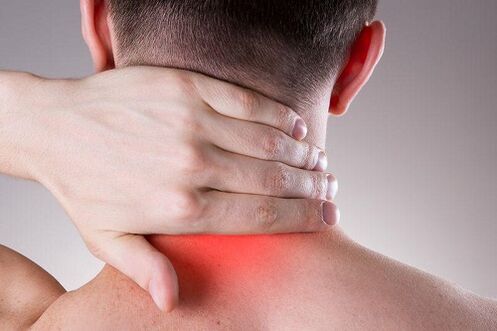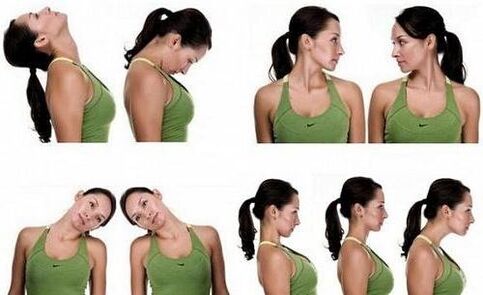The cervical spine (shopping) osteochondrosis is one of the most common pathologies of the musculoskeletal system.Every year, doctors are increasingly diagnosing this disease, and it is increasingly more severe.According to statistics, women degenerative-dystrophic changes in the upper spine occur more frequently, especially in patients after fertilization period.The main symptoms of women's cervical osteochondrosis are pain, mobility restriction, cerebral vascular failure, and this is dangerous not only to health but also to life.To protect against dangerous effects of pathology, you need to start treatment in the early stages.It is important to do a comprehensive therapy, to change lifestyle to stop the destruction of vertebrates and to prevent serious complications.
Development of the disease
The cervical spine is the most vulnerable to various injuries and degenerative changes.This is because this segment is the most mobile and the muscles here are weak.Small cervical vertebrae can withstand a strong load daily, which gradually destroys intervertebral discs.The vertebrae press each other, causing the cartilage gaskets between them to lose a lot of fluids, start to break down and deform.
In addition, osteochondrosis of the cervical spine develops due to malnutrition of cartilage.And the spinal canal in this area is narrow, so it is often squeezed, which causes neurological symptoms.
Women's pathology in the early stages occurs at the back of the head at the back of the head, tingling in the hands and so on.Often, patients confuse the first signs of the disease with excessive work.
There are many blood vessels and nerve roots on the neck area, and neurological disorders can also occur with their compression.This is especially dangerous if the deformed disc or vertebrae compresses the vertebral artery, nourishing important parts of the brain.During compression, the coordination of motion, the woman may lose its balance, vision, hearing, and the risk of stroke increases.
Link.According to statistics, cervical osteochondrosis is most commonly found in patients between 25 and 40 years.This is due to a reduction in mass physical activity, sitting work.Women are more common in women than in men because they have more fragile vertebrae and thin bone tissue.
Doctors distinguish between 4 stages of osteochondrosis store:
- Stage 1 - The intervertebral disc loses some moisture, its height is decreasing, and cracks may occur in the fibrous ring (outer shell).It is a stage of cervical chondrosis that is difficult to detect because it has undisclosed symptoms.The neck gets tired quickly, discomfort, severity in the affected area, sometimes with a slight pain that passes quickly.
- 2 stages - cracks on the surface of the disc surface, the core of pulpososis (to the gel contents of the disk) moves and can protrude through the affected areas.Thus, cartilage protrusions occur, which can squeeze the spinal cord and its roots.Periodic pain, weakness, mobility restriction, numbness of the face, neck, shoulders, hands.
- Stage 3 - The protrusion interrupts the outer disk sheath, resulting in a hernia.The pain becomes more pronounced, there are neurological disorders.
- Stage 4 - The disk is almost completely destroyed, the vertebrae rub one against each other, and in their parts the bone growth (osteophytes), which are intended to stabilize the damaged segment.Nerve endings, spinal cord, blood vessels are damaged.Neighboring joints begin to damage.The clinical signs are revealed.
It is easiest to stop degenerative dystrophic changes in the first two stages of chop osteochondrosis.In 3 stages, detailed treatment will help to stop further destruction of the spine segment.You cannot do without surgery in the final stage.
Causes
Schop osteochondrosis is a complex and long -term process that usually has several reasons.In most cases, pathology results from a sedentary lifestyle, malnutrition and metabolic disorders.Often, the disease is caused by injuries or the natural aging of the body and its protective forces.
Doctors distinguish the main causes of osteochondrosis in women:
- Violation of metabolic processes.
- Passive lifestyle.
- Genetic predisposition.
- Chronic muscle tension around the cervical segment.
- Crouping with posture.
- Lack of fluids and nutrients in the body.
- Long for stay in an awkward position (neck extended forward and hidden back).
- Too much weight.
- Frequent wearing heels.
- Shop injuries.
- To lift heavy objects.
- Autoimmune pathology.
- Frequent stress, chronic fatigue.
- Hypothermia.
- Infectious diseases.
- Too long or short neck and so on.
All of these factors provoke the nutritional damage to the intervertebral discs and cause their degeneration.
Women's cervical osteochondrosis can be caused by vertebrae artery associated with genetic predisposition, intrauterine disorders, childbirth injuries.The disease can result from rheumatism, endocrine disorders, excessive cervical segment load during pregnancy, local overload.
Important.The main causes of cervical osteochondrosis of women are menopause, as well as changes related to this period.At this stage, the body reduces the concentration of progesterone, which is very important for bone tissue.The likelihood of degenerative changes is associated with age -related neck muscles and weakening of vertebrae in this area.
Symptoms
Osteochondrosis is characterized by a wave -like course when the acute period is replaced by remission.Exacerbation can provoke infections, injuries, hypothermia, long neck load.

The first signs of cervical osteochondrosis of women are headaches, discomfort, and neck severity.It is important to distinguish the pain of chondrosis from migraine or autonomic dysfunction in a timely manner.
Clinical manifestations of osteochondrosis in women are caused by neurological syndromes:
- Cervical discs occur in irritation of the nerve endings with fragments of damaged cartilage.Then the neck appears specific crackling, pain that becomes more pronounced when the head moves after sleep.
- Stair muscle syndrome becomes the blood vessel and nerves of the shoulder plexus and subclavia artery.This complex of symptoms is accompanied by pain from the inner surface of the shoulder to the hand from the affected side.The limb becomes pale, cool, edematous, numbness.Neck pain spreads to the back of the head as the patient turns the head.
- Shoulder -smeared periartrosis syndrome - Dystrophic changes affect the tendon fibers surrounding the shoulder.The painful sensations from the neck radiate to the shoulder and shoulder.There is a forced neck position - it is prone to the affected side and the shoulder is slightly lowered.
- Spinal artery syndrome - fragments of the affected disc or osteophyte blood vessel (depending on the stage of the disease).The patient also rotates headaches, nausea, sometimes vomiting.The pain is localized at the back of the head, crown and temple.
- Cardiac - spinal nerve beams are damaged.There is heart pain, arrhythmia.When the C3 is damaged, half -neck pain occurs, the tongue swells, and the patient cannot chew food normally.If C4 is injured, then discomfort occurs in the shoulder greens, collars, heart.When the C5 is damaged, the pain reaction from the neck spreads to the shoulder, the inner surface of the shoulder.C6 irritation is manifested by pain from the neck and shoulder blade to the shoulder shoulder and spread throughout the hand to the thumb.If the C7 is damaged, the pain syndrome extends to the tip of the shoulder greens, grabbing the entire arm, including the arrow and middle finger.When compressing the C8, the pain spreads from the affected area to the elbow and the little finger.
In addition, a woman can be disturbed by the emotional sphere, weakness, becoming anxious, sensitive.Often there is insomnia, memory is weakened, attention due to regular headaches.
Symptoms of cerebrovascular disorders occur when a woman suddenly throws her back, tilts her or does a job where her hands and cervical spine are loaded, for example, when she digs, paint the ceiling, tolerates difficulty.
Cerebral circulatory damage is manifested by dizziness, trembling gait, "flying" in front of the eyes, noise in the ears, weakness, nausea.In some patients, the voice becomes stormy, sometimes disappears, and sore throat occurs.
Osteochondrosis during menopause is accompanied by migraine, which is enhanced by body sweating between the neck and shoulders.Cardiovascular work disrupts the vertebral artery.
If the disease occurs for a long time, there is a lack of important centers that perform neuroendocrine functions, blood flow.Increased vascular wall permeability develops atherosclerosis of the cerebral and cardiac artery.

Diagnosis
If you notice symptoms of osteochondrosis, go to the therapist.After the visual examination, the specialist will refer you to an orthopedist, vertebrologist or neurologist.
The following methods are used to diagnose cervical osteochondrosis:
- X -ray suggests that the patient's vertebrae are in patients with osteophytes, their edges have, and the distance between the vertebrae has decreased.The investigation is performed in different planes.To detail the characteristic changes, the doctor takes the target photos.
- The CC of the Cervical Division provides detailed information on pathological changes in the vertebrae.This method allows you to get volume pictures for a more detailed examination and is used in severe diagnostic cases.
- MRI is used to accurately assess the condition of soft tissues (nerves, blood vessels, ligaments, muscles) in the affected area.
- Electromyography allows the conductivity of the nerve fiber to be checked.
Doctors can also prescribe uzdg (ultrasound dopplerography of the main cerebral artery) to determine the condition of the blood flow in this area.
Conservative treatment
In the early stages, women's treatment of Chop osteochondrosis can be done at home.However, the doctor should consist of a doctor.It is important to understand that this is a long process and will probably not be completely cured (especially elderly women).
The composition of the complex treatment includes:
- To take medication.
- Use of orthopedic devices.
- Therapeutic gymnastics.
- Physiotherapy procedures.
- Massage, manual exposure.
- Alternative treatment methods.
Conservative methods will help stop pain, inflammation, normalize muscle tone, improve metabolic processes, and damage to the spinal segments.Pathological changes can be stopped by timely treatment of therapy.

Cervical osteochondrosis medicines will help you get rid of inflammation and pain.
In women, cervical osteochondrosis treatment is performed using medicines to improve cartilage between the metabolism of the vertebrae, to stop inflammation and pain.The following drugs are used for this purpose:
- NSAIDs.Gentle or medium power inflammation and pain will help relieve.
- Analgesics.Stop the pain syndrome.
- Preparations to improve brain circulation.
- Musodies help to remove muscle spasm.
- Chondroprotectors.They help stop the destruction of the discs, improve metabolic processes, speed up recovery.
- Majesty -based drugs.
- Nootropics.They stimulate the functioning of the brain due to the normalization of its circulatory, and have a mild sedative effect.
Link.In the case of intense pain that does not stop oral medicines, therapeutic blockade, such as with novocaine or NSAIDs, is used.
You can supplement treatment with anti -inflammatory and painkillers in the form of gels, creams and ointments.They will be effective in the remission stage or in combination with oral agents.
The decision to choose medicinal combinations is made by a doctor.The specialist will form a drug use scheme and will also determine their dose.It is important to follow his recommendations, as many of the medicines mentioned above are threatened with dangerous complications.
During the acute stage of osteochondrosis, the woman should abandon severe physical activity.To unload the cervical segment, you need to wear a special corset (Shantsa Collar), which will attach the vertebrae in the right position.It is recommended to use this device for protracted sitting or hard physical work.
Physiotherapy procedures will help to reduce pain and improve blood circulation in the affected area:
- Diadamotherapy.
- Magnetotherapy.
- Electrophoresis.
- Electroanalgesia.
- Ultraviolet irradiation and so on.
The therapeutic effect occurs after a third session, then headache, hearing impairment, vision, dizziness, sleep and general condition improves or disappears.
With an underwater adhesion of the cervical segment, you can expand the distance between the vertebrae, loosen the nerve or blood vessel from compression and restore the normal position of the vertebrae.
Massage will normalize muscle tone, reduce the flow of lymphatic fluid, which causes swelling.Following several sessions, blood circulation in the affected area improves.

Therapeutic gymnastics is one of the most effective treatments for Chop osteochondrosis.The LFK allows you to strengthen the weak neck muscles, which will subsequently take part from the spine and help stop or slow down degenerative dystrophic changes.Classes improve metabolism processes, metabolism, and disk nutrition accelerates, which has a positive effect on their condition.
Women should conduct training every day.They consist of simple but effective exercises.The complex consists of turns, head tilt in different directions, as well as neck movements that are used.These elements can be done at home, but only with the permission of the doctor.Medical physical education is performed only during the remission phase.
Sophisticated treatment can be supplemented with reflexology (acupuncture), hirudotherapy (name treatment), swimming and so on.
Surgical treatment
The operation is determined in the last stages of osteochondrosis of cutting, accompanied by serious destruction of bone oocal structures.Surgical intervention cannot also be performed if conservative methods have been ineffective or the spine canal has narrowed significantly.
In the above cases, anterior cervical discoctomy is performed.During the procedure, the doctor immobilize the affected segment of the spine and removes hernia, which compressed the spine nerve.The vertebrae, between which the disc was removed, was then released.If necessary, the space between the vertebrae is filled with a synthetic liner (Cage).
After 3-5 days, the patient is released home.The rehabilitation period is about 12 weeks.To speed up your recovery, you need to take medication, wear a corset, live the right lifestyle, go to physiotherapeutic procedures and do exercise therapy over time.
Life Recommendations
To quickly get rid of the unpleasant symptoms of osteochondrosis and stop degenerative dystrophic changes in the cervical segment, you need to adjust your lifestyle.For this purpose, the patient must follow the following recommendations:
- Go for hiking daily, avoid running, jumping and other explosive stress.
- You can't wear heavy items.
- You cannot sit for a long time, in extreme cases to wear a corset and periodically occupy a horizontal position.
- Perform special exercise at home for muscles.
- Sleep on an orthopedic mattress and special pillows.
- Follow your diet, add a diet with products rich in magnesium, calcium (nuts, dairy products, seafood, legumes), as well as plant fiber, chondroitin (jelly, jelly).Give up oily, fried, too much salt food, alcohol.Read more about the power rules that your doctor will advise.But in any case, it should be right.
Numbering cannot be allowed, heating will be useful if there is no inflammatory process.
Complications
In the absence of timely treatment of cervical osteochondrosis, the woman may feel the following pathology:
- The likelihood of a shot occurs, which turns into a hernia after a while.The kit compresses the spinal cord, as well as nerves, causing neurological disorders.
- Osteophytes appear to be severely damaging the disc and irritating the spinal nerves and blood vessels.
- In advanced cases, it is possible to severely weaken the neck muscles or incomplete paralysis, then the head accidentally hangs to the side or forward.
- Compression of vertebrae artery, circulatory damage in the affected area.This condition can cause neuralgia (pain along the nerve), hearing impairment and vision.
- Paralysis (incomplete or full) hands.
- A brain stroke.
If a woman begins to solve the problem in the early stages of the store in osteochondrosis, then she will be able to warn the above conditions.
Preventive measures
Ideally, the prophylaxis of chopo osteochondrosis is necessary during the period of intrauterine development.The mother of the future should eliminate the factors that adversely affect the development of the fetus: infections, oxygen starvation, intoxication.If there is a birth injury, then the newborn should be treated.
In order to reduce the likelihood of Chop osteochondrosis, the woman must follow the following recommendations:
- For example, stop the spine evenly, for example, carry the load in both hands or in turn to the right and then to the left.
- Do not lift too much weight.
- Try to avoid neck injuries, hypothermia.
- When working in the garden areas, take a break every 1.5 hours, go for a rest for 20 minutes.
- Choose shoes with an elastic sole that will soften the impact during running or jumping.
- With a long seat, use a chair with a high back and head rest or place on a corset.
It is also important to eat, control weight, avoid stress, and perform vitamins for medical reasons, timely treatment of pathologies that can cause osteochondrosis.It is recommended to visit sanatoriums during the remission phase to carry out a course of treatment.
The most important thing
As you can see, osteochondrosis of the cervical spine is more common than men in the cervical spine, as they are the first to have more fragile vertebrae and thin bone tissue.Patients are particularly susceptible to patients after -linguistic period.The disease is characterized by pain, neurological disorders, as well as dangerous symptoms of the cerebral vascular accident.It is recommended to start treatment in the early stages to prevent dangerous complications of osteochondrosis.To do this, the woman should take medication, adjust her lifestyle, visit physiotherapy procedures, massage, perform physiotherapy exercises.Surgical treatment is only shown in advanced cases.To prevent pathology, you need to monitor moderate physical activity, treat injuries and diseases that can provoke osteochondrosis in time.



























































































